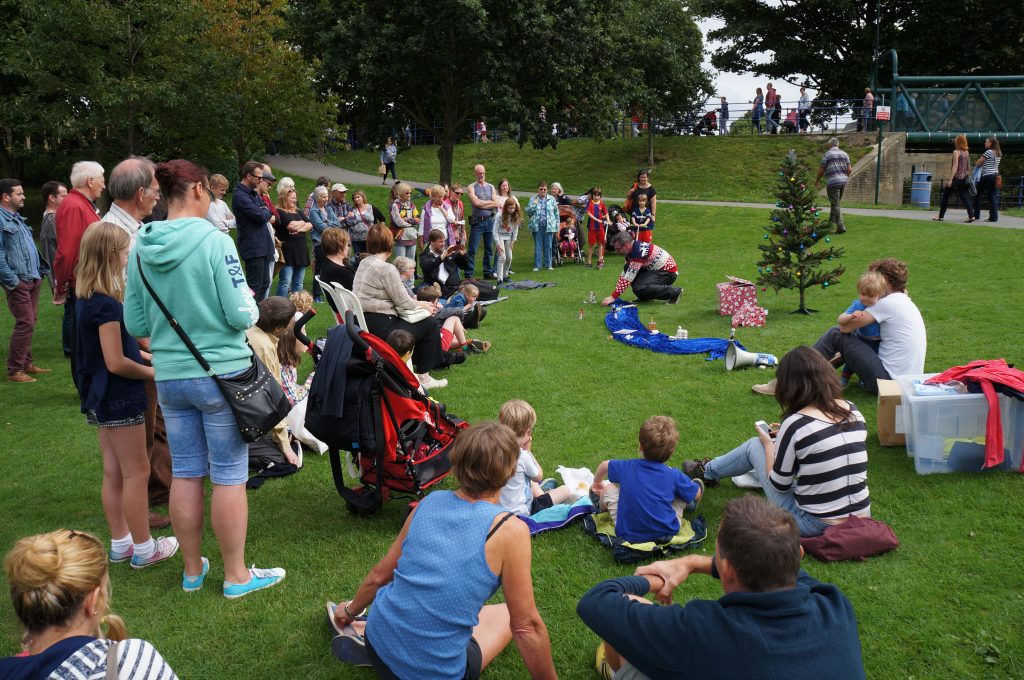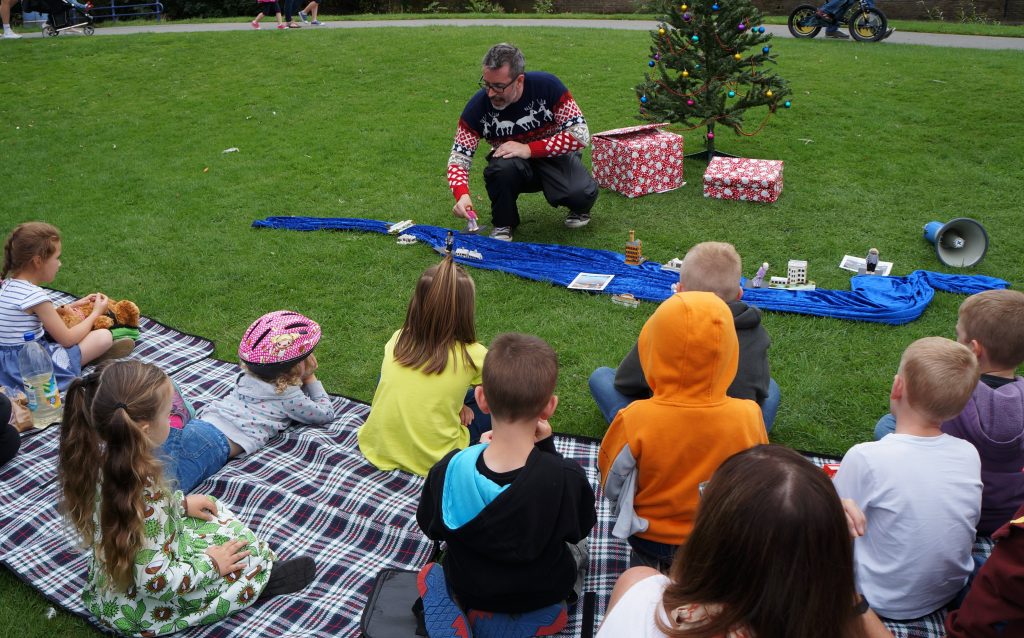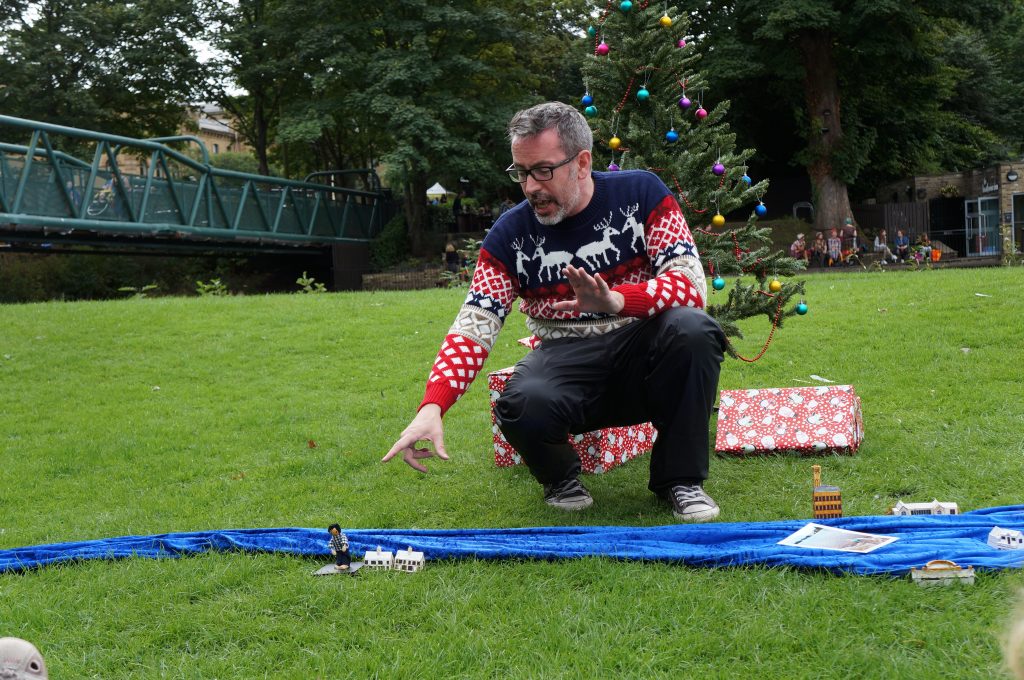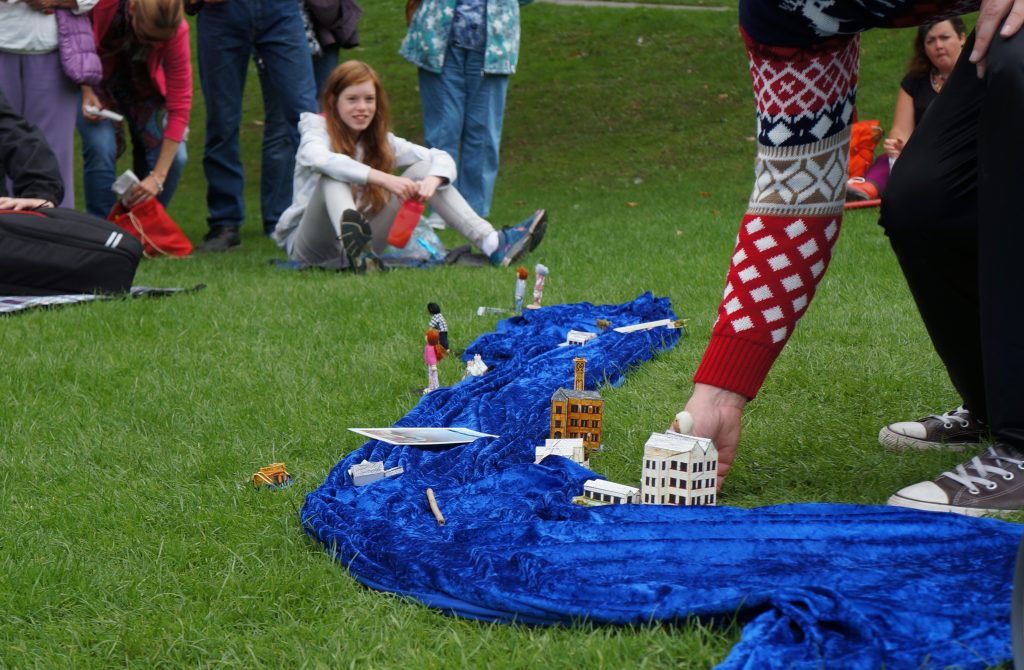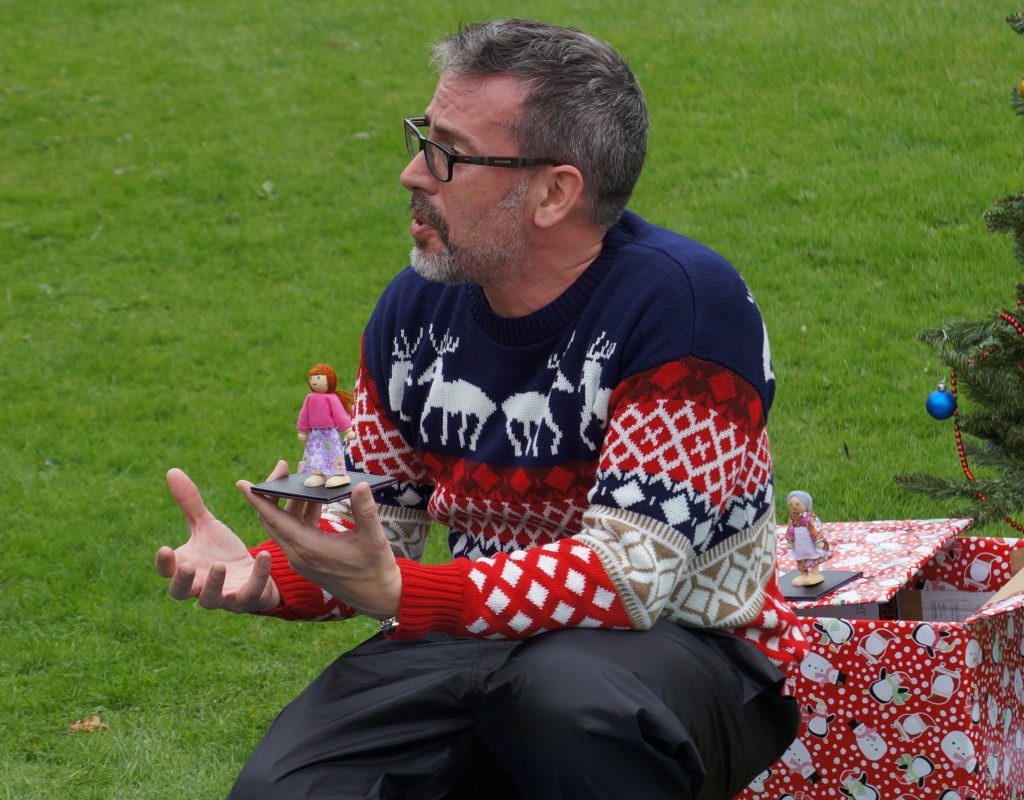Too Much of Water is a one-man storytelling show which explores the impact of the Boxing Day floods of 2015 on people living in the Shipley and Baildon area. It uses simple props and a big bolt of blue cloth to map out the River Aire and its surroundings, in miniature, as it flows down the valley. Small wooden figures represent some of the people whose flood experiences are woven together by the story – and who were interviewed by writer-performer Steve Bottoms (i.e. me) during the research process.
This piece is still available for performance. For full listing of showings to date, see bottom of this page.
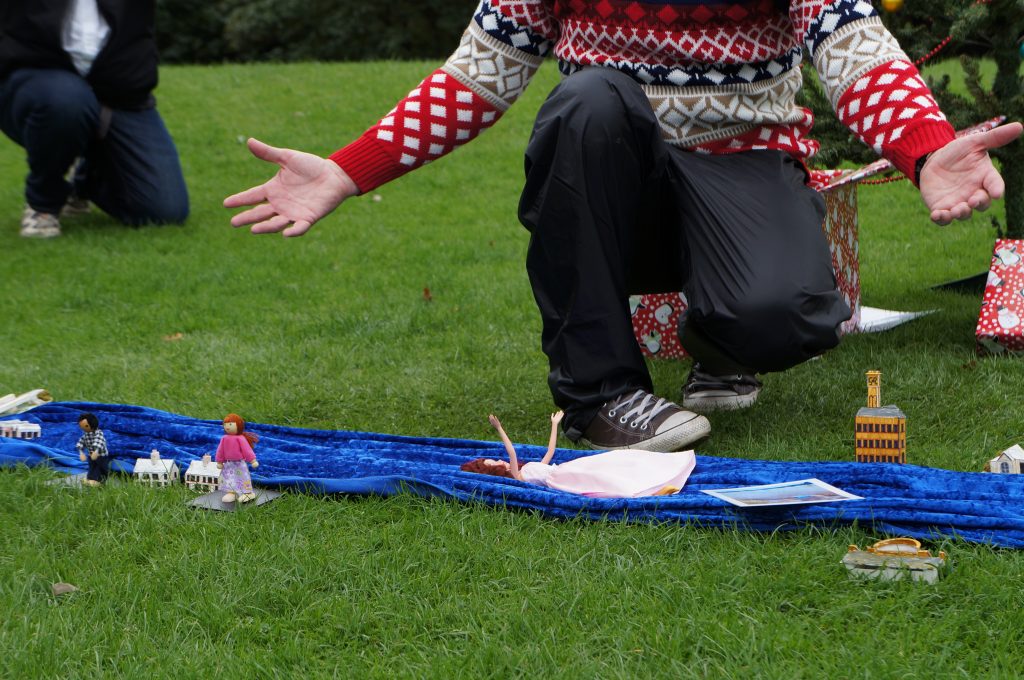 The show was originally developed for presentation in Roberts Park as part of the 2016 Saltaire Festival, as a companion piece to the Power of Water exhibition (mounted by the festival in Salts Mill, this too looked at the floods). Since then, it has been performed in other locations far and near, for a wide variety of audiences (full list of dates and relevant links at the bottom of this page).
The show was originally developed for presentation in Roberts Park as part of the 2016 Saltaire Festival, as a companion piece to the Power of Water exhibition (mounted by the festival in Salts Mill, this too looked at the floods). Since then, it has been performed in other locations far and near, for a wide variety of audiences (full list of dates and relevant links at the bottom of this page).
The piece was filmed in a television studio at Bath Spa University, in February 2017. Subsequent to this, though, Steve revised the script to incorporate an additional character (Brian Tuxford was interviewed in November 2016, after the first performances). You can read the final, revised script here.
The following photographs, by Tori Watson, are from the Saltaire Festival performances.
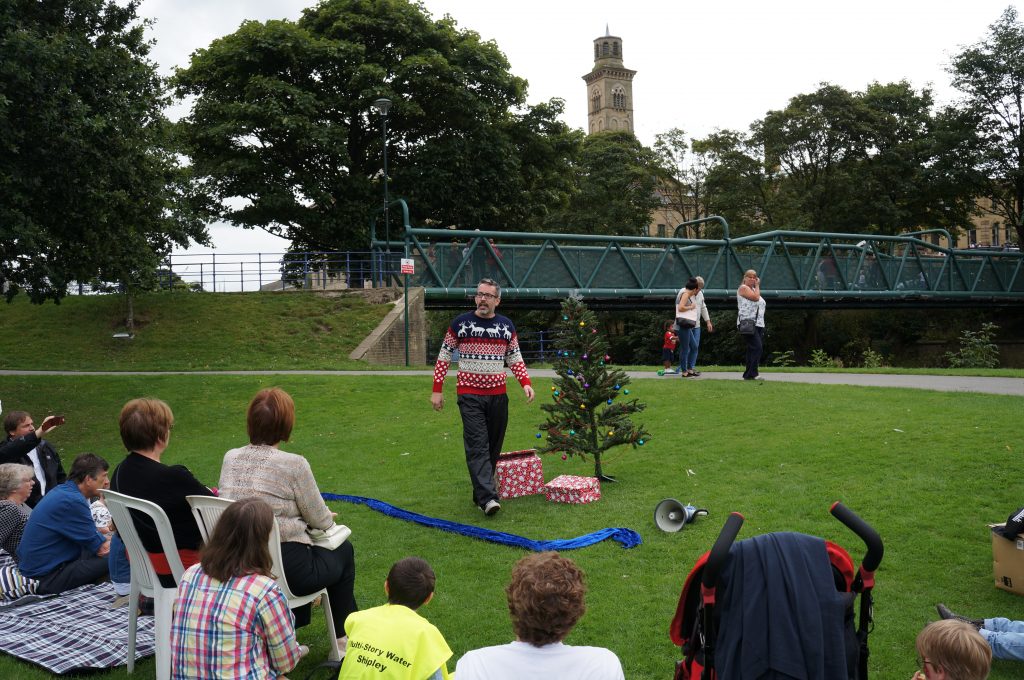
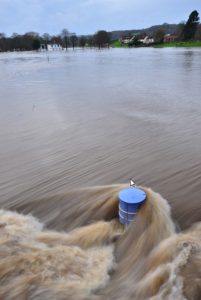 At Saltaire Festival, the play was staged in close proximity to the River Aire (see footbridge in the photo above), in an area of the park that was completely underwater during the flood. Indeed, a particular feature of the piece is the blue rubbish bin visible in this picture to the right — taken from the footbridge on the day of the flood. You can see this same bin, which valiantly stood upright against the onslaught of water, behind me in the shot below.
At Saltaire Festival, the play was staged in close proximity to the River Aire (see footbridge in the photo above), in an area of the park that was completely underwater during the flood. Indeed, a particular feature of the piece is the blue rubbish bin visible in this picture to the right — taken from the footbridge on the day of the flood. You can see this same bin, which valiantly stood upright against the onslaught of water, behind me in the shot below.
Here, I’m placing the first of the architectural models (representing Salts’ New Mill) made specially for this performance by Stewart Gledhill.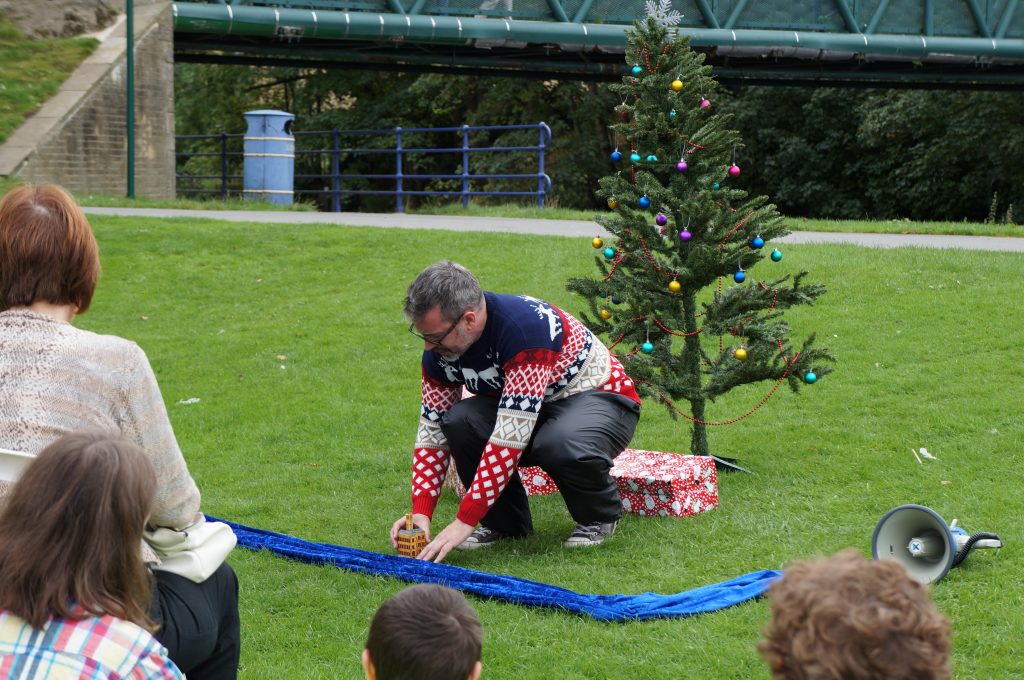
As befits a festival performance, there’s some gentle audience participation involved at the beginning, as spectators are invited to select flood warning statements from a range of stock phrases used by the Enviroment Agency, and read them out with a megaphone. The results were, as I’d hoped, both amusing and a little uncomfortable…
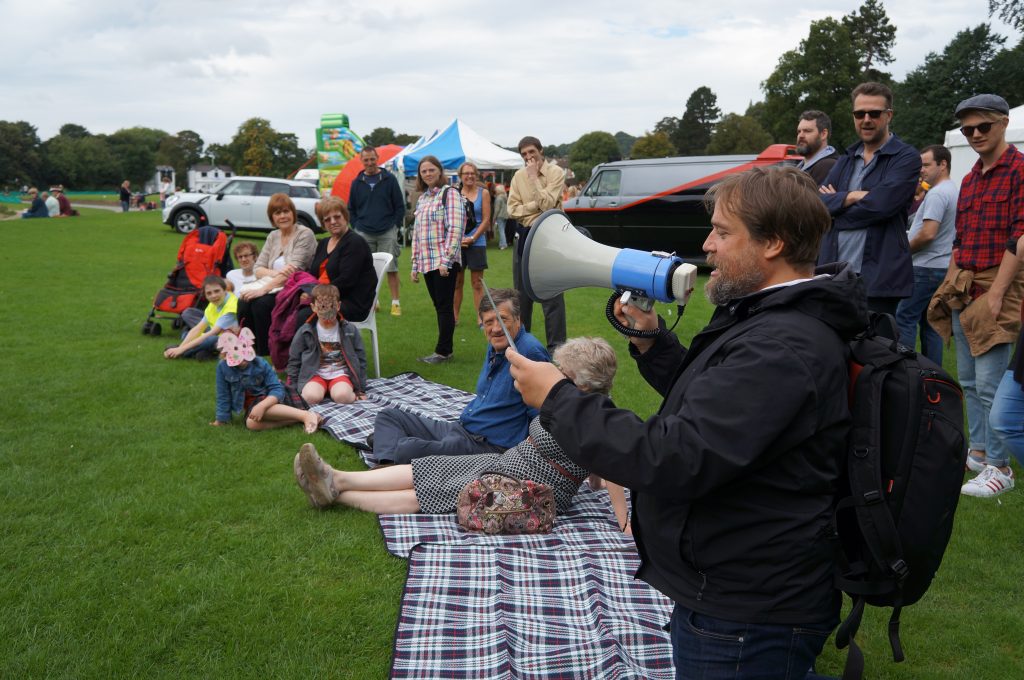 During all of the four (free) performances given over the first weekend of Saltaire Festival, the watching crowd steadily gathered in size as the performance went on…
During all of the four (free) performances given over the first weekend of Saltaire Festival, the watching crowd steadily gathered in size as the performance went on…
… I’m proud to say that this always included plenty of children, who seemed as engaged with the story as any of the adults (see below), despite the fact that I made no particular attempt to “play to the kids”. Although visually I’m using children’s toys, the narrative is a direct and fairly hard-hitting account of how people were affected by the flood.
The figure being pointed out below, for example, represents Phillip Moncaster — whose concerns about the possibility of a major flood were documented on this blog before Christmas 2015. His home and the working men’s club he runs were both badly hit.
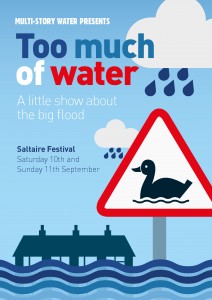 The premise of this piece is that it is “a little story about the big flood” (as the tag-line on the flyer has it). That is, it tells some of the “little stories” of how individuals were affected, rather than the “big story” of wider crisis (in the way the news media tends to). It focuses, particularly, on domestic details of the sort you might not normally hear about, but to which any of us can relate.
The premise of this piece is that it is “a little story about the big flood” (as the tag-line on the flyer has it). That is, it tells some of the “little stories” of how individuals were affected, rather than the “big story” of wider crisis (in the way the news media tends to). It focuses, particularly, on domestic details of the sort you might not normally hear about, but to which any of us can relate.
In the scaled-down dynamic of the performance, there are also some visual twists such as this little stick (below) becoming the “massive tree trunk” that punched a hole in Hirst Weir.

The form of the piece was also inspired by the fact that so many of the people I interviewed during my research described the events of the flood according to the times of day in which things happened. People vividly remembered what the clock was saying when certain events occurred. This meant I was able to cross-reference events up and down this stretch of river, as they happened in chronological sequence… but visually, this demanded that I could show the whole stretch of river in microcosm…
One friend who saw the performance described it on Facebook as “a little gem of verbatim theatre”. That’s a term used to describe plays that are based on interview transcripts. But in this case, I told a story based on what people told me, rather than quoting them “verbatim”. Only towards the end of the piece do I sum up by quoting some of my interviewees’ concluding thoughts. At this point, the relevant figures are held up to “speak” – as with “Ann” below.
At the end of the piece, there’s also some verbatim quoting from Shakespeare! My title, Too Much of Water, is stolen from Hamlet (Laertes: “too much of water hast thou, poor Ophelia, and therefore I forbid my tears”), so I finally bring in one last figure, my daughter’s “Belle” Barbie doll (i.e. Belle from Beauty and the Beast), to stand in as the drowned Ophelia. And yes, I worried slightly that throwing Hamlet in might seem a bit pretentious in this context, but it seems to work for most people…
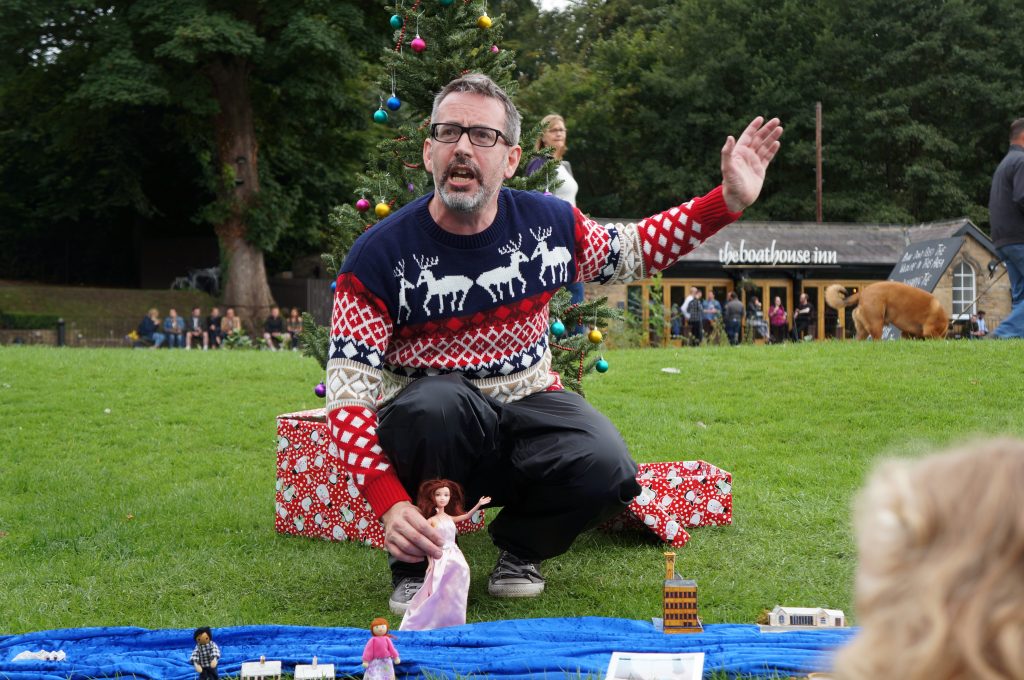 One of things I especially liked about performing in the park was the way that spectators would just hang around afterwards, sometimes for quite a while, discussing the flood and the stories told. Here, one parent is explaining a detail to his son…
One of things I especially liked about performing in the park was the way that spectators would just hang around afterwards, sometimes for quite a while, discussing the flood and the stories told. Here, one parent is explaining a detail to his son…
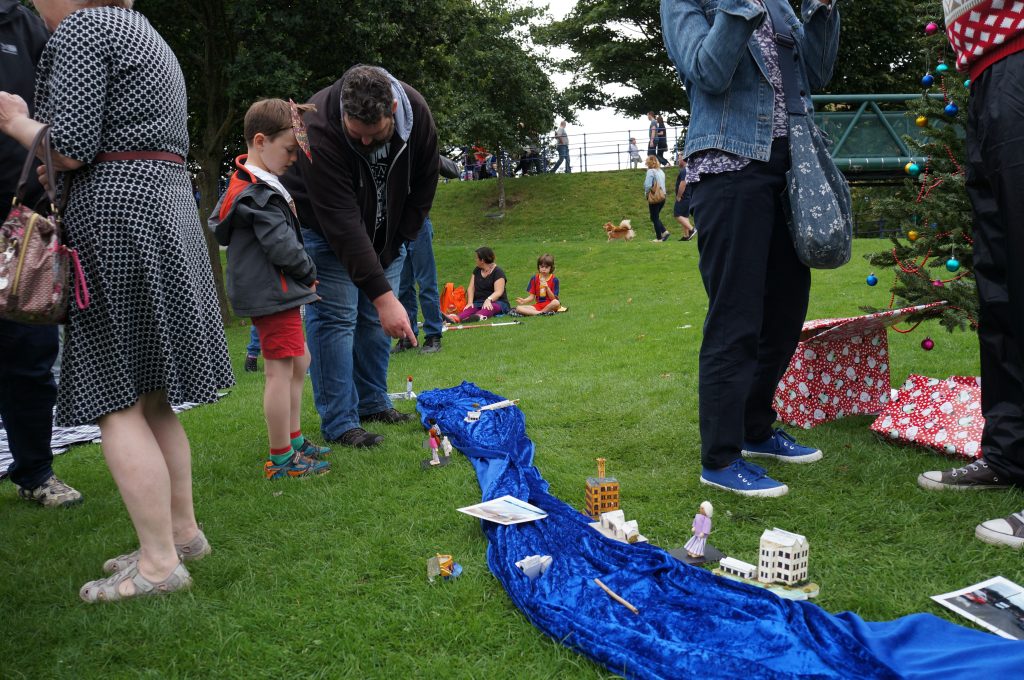 I’m also very pleased to say that a number of my interviewees were able to attend the performances. Pictured below is Margaret Wright, from Lower Holme, holding up the doll who “plays” her in the show. Margaret has teased me a bit about depicting her as a little old lady, but I only had so many options with the dolls available! (Sorry Margaret…)
I’m also very pleased to say that a number of my interviewees were able to attend the performances. Pictured below is Margaret Wright, from Lower Holme, holding up the doll who “plays” her in the show. Margaret has teased me a bit about depicting her as a little old lady, but I only had so many options with the dolls available! (Sorry Margaret…)
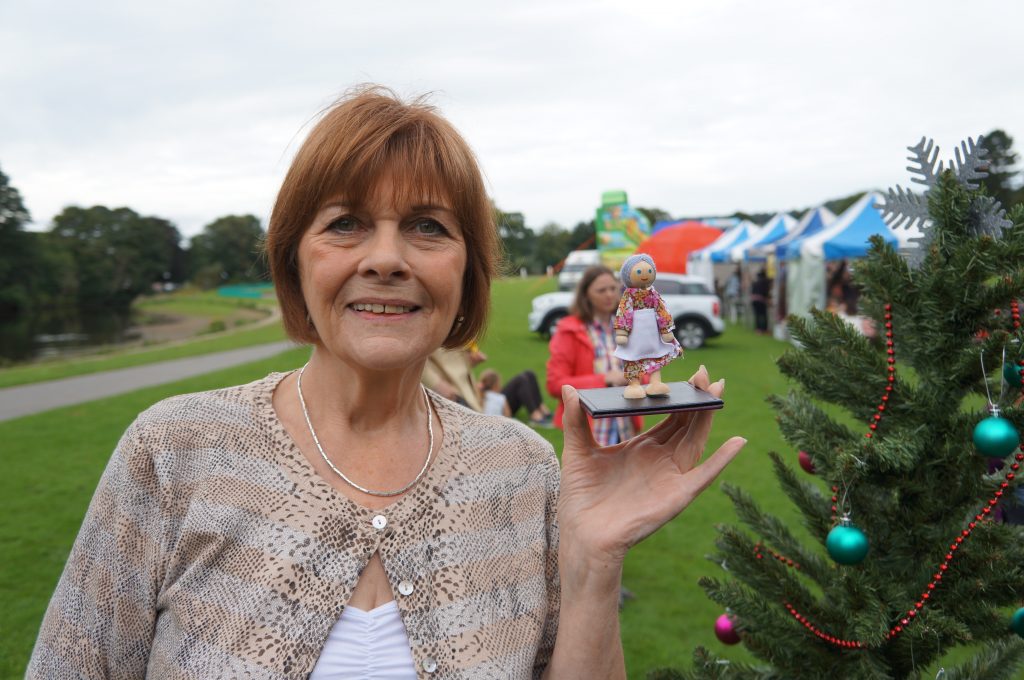 Joking aside, of course, the story of the flood was not really a laughing matter for anyone affected by it. At the time of the first performances, almost nine months after the flood, some of my “characters” (such as Ann, below) had still not been able to move back home… For his part, Phillip was looking to sell up and move out…
Joking aside, of course, the story of the flood was not really a laughing matter for anyone affected by it. At the time of the first performances, almost nine months after the flood, some of my “characters” (such as Ann, below) had still not been able to move back home… For his part, Phillip was looking to sell up and move out…
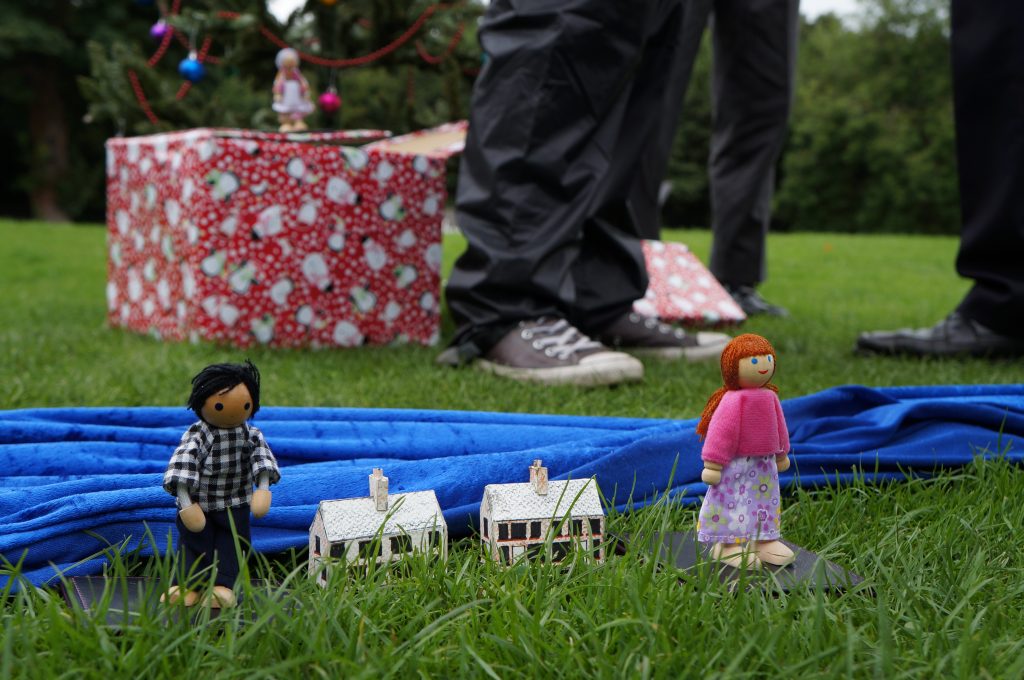 Even so, one thing I noticed in my interviews with all of these people was that they used black humour to describe some of what had happened to them. Perhaps that’s a natural survival mechanism – a way to fight through the difficulties. So I tried to represent some of that in the show, as well as the seriousness of the situations facing people… In the end, of course, it’s for the audience to judge whether or not I got that balance right.
Even so, one thing I noticed in my interviews with all of these people was that they used black humour to describe some of what had happened to them. Perhaps that’s a natural survival mechanism – a way to fight through the difficulties. So I tried to represent some of that in the show, as well as the seriousness of the situations facing people… In the end, of course, it’s for the audience to judge whether or not I got that balance right.
Performance dates and locations:
[links indicate further information on given performances, including documented feedback etc.]
Roberts Park, Saltaire (for Saltaire Festival) 10th & 11th September 2016
St. Peter’s Church, Shipley (for Saltaire WI) 13th October 2016
Roborough Studios, University of Exeter 1st November 2016
Theobalds Park Hotel, Cheshunt 8th November 2016
Alison Richard Building, University of Cambridge 21st November 2016
Open Source Arts, Leeds (see poster below) 23rd November 2016
Martin Harris Centre, University of Manchester 7th December 2016
Leeds Industrial Museum (for exhibition launch) 8th December 2016
Baildon Woodbottom WMC, Shipley (blog here) 18th December 2016
The Brunswick, Leeds (for The Superposition) 29th March 2017
Kirkgate Centre, Shipley (for exhibition launch) 22nd July 2017
Workshop Theatre, Leeds (for ICFM7) 4th September 2017
Mytholmroyd Festival, Calderdale 14th October 2017
Leeds Town Hall (for Insurance Institute of Leeds) 14th November 2017
Brockholes School, Huddersfield (for ‘Water of Life’ STEM week) 19th March 2018
Birkbeck, University of London (for Creative Climate symposium), 8th May 2018
University Place, U. of Manchester (for Sustainability Seminar Series), 10th May 2018
Whitworth Hall, U. of Manchester (for annual Green Impact Awards ceremony), 7th November 2018
Honley CofE Infants School and Honley CofE Junior School (2 performances for STEM week activities) 20th May, 2019
Merrion House, Leeds (for Leeds City Council Flood Risk Management team), 28th November 2019
Deloitte’s, City Square, Leeds (for Insurance Institute of Leeds), 5th February 2020
University of Loughborough 7th February 2020

